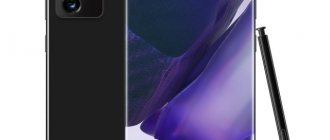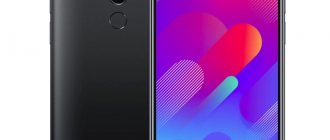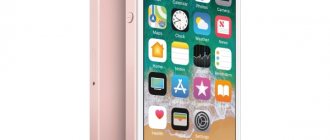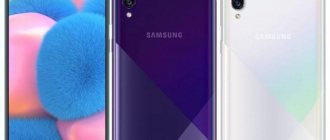Photo: pixabay.com
Are you planning to upgrade your phone and are faced with the problem of choosing between the long-time favorite Samsung and the relatively young but promising brand Xiaomi? The confrontation between these companies has become very heated, and this plays into the hands of ordinary consumers, that is, us. Let's figure out what innovations the famous Korean brand Samsung can offer and how Chinese Xiaomi responds to this.
Xiaomi vs Samsung: processor and operating system
In terms of technical components, Samsung smartphones have always been and remain at their best, even surpassing their competitor Xiaomi. But it’s fair to note that this applies mainly to flagship models, while for “state budget” models everything is not so clear.
The Chinese manufacturer uses the Qualcomm chipset even in inexpensive phones. In terms of performance, it is considered one of the best in its class. The company does not install cheap processors, with the exception of some of the most budget smartphones.
Samsung has a slightly different policy. There are quite a lot of models in its line with gradually aging processors. Modern models are equipped with Exynos chips, which, although slightly, are inferior to their competitor Qualcomm, all other things being equal.
Qualcomm Snapdragon 8 series is the flagship line of performance chipsets. Most Xiaomi smartphones work on them. Photo: pixabay.com
For a full comparison of Samsung and Xiaomi, you should also pay attention to their operating systems:
- The “Chinese” uses its own MIUI platform, created on the basis of Android, but differs favorably from it with more flexible settings. Some users consider this system to be the best on the market, although there are many haters.
- Samsung smartphones are released with pure Android, which initially has a minimal set of applications. The manufacturer invites users to independently choose what is more convenient for them to use.
It is impossible to clearly select the best operating system. For example, some people don’t like that they spend a lot of time getting to know MIUI: they have to start by studying many applications and filtering out the unnecessary ones. However, if you are used to Chinese smartphones, this will not be a big problem.
As for Android, some users call its main disadvantage the placement of a minimum number of settings in the “curtain”. In outdated versions (below Android 9.0), you cannot edit anything at all. In MIUI, in turn, you can set any parameters at your discretion.
The latest One UI shell for Android, which Samsung has been using since 2022 (previously Samsung Experience), has become much more convenient than its predecessor. For example, the long-awaited dark theme for the interface has appeared.
Design
When choosing a new smartphone, everyone first of all pays attention to its appearance. Perhaps only techno-geeks (people obsessed with technology and fluent in all its aspects) can completely ignore the design factor and choose a device solely based on its technical equipment.
Samsung
The A-series smartphones, with which we will begin, adopt a lot of technology from Samsung's flagship devices. The materials used are mostly ordinary plastic; in some more expensive models, the choice is made in favor of “glastic” (a mixture of plastic with carbon fiber on an aluminum frame, very reminiscent of glass in tactile sensations).
Now the fingerprint scanner in each A-series representative is not placed outside on the back cover and is hidden in the power button (more budget models), or directly in the display (starting from the Galaxy A32). The company can definitely be praised for this, since quite recently this arrangement was only relevant for flagships and smartphones close to them.
The front camera, also depending on the specific model, is located in a drop-shaped cutout in the center of the display, or in a small circular hole. On the back cover there is a corporate logo and a vertical camera block. Nothing superfluous - what is called a minimalistic design. However, some budget phones (Galaxy A02, for example) have an interesting corrugated cover with patterns. More expensive devices have a more discreet and strict appearance, which makes them even more expensive.
It is also worth noting that in the older models of the 2021 Galaxy A line, the company introduced IP67 water protection, which to this day is found mainly in flagship-level devices or directly protected smartphones.
We must not forget about the M-series. Externally, smartphones in this line can hardly be immediately distinguished from A-series devices, but there are still several differences:
- Plastic is almost always used. Surprisingly, even in models costing 30 thousand rubles or more (Galaxy M62).
- Often the fingerprint scanner is located on the back cover (Galaxy M31, M11).
- Less rich color range. Usually there are 2-3 types of colors: black, white, blue.
Redmi
Now let's look at the appearance of Redmi smartphones. Looking ahead, the design of Xiaomi models will be a little more interesting, especially if we talk about the top representatives of the line.
As with Samsung, the external component greatly depends on the cost of the specific device. Inexpensive representatives of the Redmi series are distinguished by a cheap plastic case, a front camera in a drop-shaped cutout and a fingerprint scanner, which is located on the rear panel.
So that such smartphones (Redmi 9C, 9A, 9T) do not look too cheap and have at least some zest, the manufacturer added a corrugated coating and a variety of colors to some of them. Red, orange or bright blue often looks more interesting, and even trivial this can catch the eyes of users.
More expensive phones, such as Redmi 10, Note 10 Pro, Note 10S and others, can boast a much better approach to appearance. The case here in some cases is made of glass (back panel), or of glossy plastic, which is called “glass-like”.
Xiaomi has completely abandoned the drop-shaped cutout if we are talking about any Redmi smartphone costing more than 15 thousand rubles. An island of minimal diameter is allocated for the front camera right in the display. The rear camera block looks quite impressive even compared to Samsung smartphones and gives the impression that the device has high-quality optics.
In terms of color scheme, Redmi completely beats Samsung. If the latter most often use monochromatic colors, and do not offer the widest selection of colors, then devices from the Chinese manufacturer often look more interesting thanks to the rear panel with a gradient effect.
Comparison table:
| Samsung | Redmi | |
| Design | — | + |
| Total: | 1 | 2 |
Xiaomi vs Samsung screens
Comparing the displays in the battle of Xiaomi and Samsung phones, the victory can be given to the “Korean”, if only because it is he who is considered the trendsetter. It is Samsung that usually introduces new technologies in this area, and its matrices are used by Apple itself for its iPhones. Even inexpensive Samsung smartphones are equipped with high-quality AMOLED displays.
Xiaomi also has good screens, but only in the high and mid-price segments. State-priced models have an IPS matrix, which has flare at the edges and is not capable of providing deep blacks.
With all the advantages, Samsung screens have one significant drawback for some users. For some reason, the company does not use the DC Dimming function to reduce the flicker frequency. This is a very useful technology, thanks to which the eyes do not get tired so quickly when interacting with the phone for a long time. IPS displays are preferable in this regard, although they do not have the best color reproduction.
The DC Dimming feature is very useful if you do a lot of reading on your phone screen. It makes your eyes less tired and your vision is preserved. Photo: overclockers.ru
Which phone is better built - Xiaomi or Samsung
In terms of build quality and design, Chinese smartphones are gradually catching up with the famous brand. Gradually, Xiaomi even introduces such pleasant little things as wireless charging. The Chinese manufacturer cannot, unlike Samsung, boast the same dust protection and water resistance of smartphones, but they also have their own tricks. For example, some models were equipped with retractable front cameras, although not all users found this solution successful.
In general, it is difficult to single out a clear leader in the assembly and design of models - everyone chooses what they like best. From a visual point of view, both Galaxy, Redmi, and Xiaomi Mi look decent and modern.
Samsung smartphones are a little thinner and lighter than the “Chinese” ones, but that’s where the advantages end. For example, when the battle between the Galaxy A10 and Redmi 8 unfolded on the market, the latter were clearly more interesting. Their back panel still looks stylish and original, while Samsung's initially looked cheap.
As for the flagship models of 2020–2021, here the first place in terms of visual component can be given to Samsung smartphones. In terms of protective characteristics, they are also excellent. For example, the Galaxy S21 has an IP68 protection rating, while its direct competitor, the Xiaomi Mi 11, does not have it at all.
With IP68 protection, the smartphone is dust-resistant and can be submerged in water to a depth of 1 meter for more than 30 minutes. Photo: businessinsider.com
Camera
Here Xiaomi is definitely not in the top, the old versions that were popular a couple of years ago are especially sad. They had mediocre sensors and mediocre color reproduction, so the pictures came out blurry and noisy. Xiaomi understood the problem and worked on a solution, so each new model came out better than the old one. There is an HDR mode, a zoom camera, improved color reproduction, and portrait photography with an editor. That is, gadgets are gradually being “pulled up” to a decent level.
Haomi cameras are far from Samsung. Koreans are the standard model. Even budget-priced cameras are of a high standard; they take excellent pictures; premium lines are comparable to SLR cameras in terms of shooting quality. Flagships with middle-class devices are ahead of the “Chinese” in terms of a set of parameters - night photography, contrast, color reproduction, clarity.
Which smartphones take better photos - Samsung or Xiaomi
For many users, the camera is one of the main criteria for choosing a phone. The Chinese manufacturer uses fairly high-quality modules, which are created with the support of the legendary Leica brand. Many experts consider these products to be better than many analogues, but this is only true for flagships. Budget and mid-budget, as well as simply outdated Xiaomi models are definitely behind Samsung in terms of shooting.
Koreans even install high-quality cameras in budget models that are superior to competitors in their price segment. If we compare flagships, Samsung is generally one step ahead in all respects: color reproduction, quality of night shots, clarity of video stabilization, and so on.
However, if you prefer to shoot at a wide angle, Samsung's budget models may disappoint you. This is their weak point, since phones are equipped with a cheap wide-angle sensor. It negates detailing, distortion correction (this is a certain type of image deformation) and creates a pronounced “barrel” effect (curvature of the image at the edges). Xiaomi from the budget segment is head and shoulders above in this regard, but it also lacks stars from the sky.
Without going too deep into other details, we can give two recommendations regarding cameras:
- If you buy a flagship model, take a closer look at Samsung: they take better pictures.
- If you are looking for a budget or mid-budget option, you should still pay attention to Xiaomi.
Xiaomi Mi 11 abandoned the huge scattering of cameras on the back side, leaving a small, neat unit with an impressive main lens. Photo: mashable.com
Let's sum it up
When looking at reviews about whether Xiaomi or Samsung is better, you may come across a polarity of opinions. Many users do not perceive the Chinese manufacturer at all and prefer proven brands. But for many buyers, the issue of price comes first, and that’s when Xiaomi phones come first. In order not to make a mistake in your choice, it is important to consider what exactly interests you in a phone:
- If performance and speed come first, it is better to give preference to Xiaomi.
- For lovers of products from trusted brands, Samsung will be more suitable, because the name of this manufacturer is on everyone’s lips, and its experience speaks for itself.
- Samsung is still better in terms of camera and display, but here the situation is gradually leveling out and Xiaomi phones are catching up with their competitors in these indicators.
- Xiaomi has a better pricing policy. But again, here you need to look at the lineup. If we talk about mid-range phones, the prices are almost the same, but in the case of flagships the difference can be very large.
When choosing, decide what exactly you need - camera, speed, autonomy or other parameters. Given your priorities, you need to make a choice. There are no phones that are perfect in every way. If you get one, it will be very expensive and not always affordable.
Which smartphone - Xiaomi or Samsung - has more memory?
In this regard, both manufacturers achieved good results (128 GB and above), with the exception of the cheapest models. In them, the memory capacity is at 32 GB, sometimes 64 GB, for example:
- Galaxy A02 and A02S – 32 GB
- Galaxy A12 – 32 or 64 GB
- Redmi 9, and - 32 GB
- Xiaomi Poco M3 – 64 GB
Almost all smartphone models of both brands have a microSD memory card slot, which in most cases solves the problem of lack of free space. As for the flagships, everything is also approximately the same with them, so it is impossible to single out a leader in memory capacity among the two companies.
What is inside
To understand whether a Xiaomi or Samsung phone is better, you need to compare the hardware and hardware platform. The review will be equivalent to a pair of budget phones – Redmi 5A and Galaxy J3. Characteristics:
- Processor – Qualcomm Snapdragon 425 for the Chinese and Exynos 4 Quad 7570 for the competing Korean. There is no difference in operational parameters.
- Graphics accelerator – Samsung has integrated a budget Mali-T720 MP2 chip, Xiaomi boasts Adreno 308, a powerful and productive accelerator that is usually found in the middle class.
- Memory – here the indicators are equal, that is, 16 GB of built-in, 2 GB of RAM and 4 cores at 1.4 gigahertz frequency.
That is, the filling of the budget Xiaomi is at the same level, and at a competitive price it is not inferior to Samsung. But this is if you take economy class, and there are also flagships. Let's compare the Mi6 for Xiaomi and S8 for Samsung:
- The central processor is Qualcomm Snapdragon 835 in Mi6, the same in most Samsung flagships, but Exynos 8895 is also found.
- Memory – Samsung has 2 GB more RAM (6 versus 4).
- The graphics chip is Adreno for the Chinese, Mali-G71 for the Korean. According to various reviews and tests, video accelerators are almost the same.
In the flagship class, Samsung devices win, but not critically. The price difference is significant – in favor of Xiaomi.
How to compare the battery life of Samsung and Xiaomi
Smartphones from the Chinese brand deserve the palm in terms of battery life, although Samsung is constantly improving this indicator. Xiaomi adheres to a simple principle: install a larger battery, losing the lightness and minimal thickness of the smartphone. Even budget phones from Xiaomi have a battery of 4000 mAh, while cheap Samsung ones have a battery capacity of approximately 2500–3000 mAh.
Although there are exceptions. Mi Note 10 has 5260 mAh, while its competitor Galaxy M21 has 6000 mAh. If we compare the latest Xiaomi Mi 11 and Galaxy S21 models, the Chinese are ahead here: 4600 mAh versus 4000 mAh.
These are numbers, but what about real autonomy indicators? Everything is not so clear here. Due to more energy-efficient displays and other features, Samsung smartphones are often as good as, and sometimes even superior to, their competitors in operating time. For example, when watching a video, a full charge of the Xiaomi Mi 11 lasts for 14 hours, and the Galaxy S21 lasts for more than 15 hours. And this is provided that the latter has a battery capacity of 600 mAh less.
Flagship comparison
When choosing what to buy - Samsung or Xiaomi, many users look at the manufacturers' flagships. At the time of writing, the best phone from the Chinese manufacturer was Xiaomi Mi 9 Pro.
This is a powerful device that has on board:
- OS Android 9 and MIUI 10.3,
- Qualcomm 855 processor,
- 6 GB of RAM and 128 GB storage (there is an option with 64 GB).
- The phone has a triple camera of 48, 13 and 8 MB,
- There is a 4000 mAh battery and many communication technologies (bluetooth 5.0, NFC, GPS and others).
The phone has a beautiful appearance, stylish design, and the ability to install two SIM cards. The Amoled screen demonstrates the manufacturer’s commitment to the best Samsung traditions. The price of the Xiaomi flagship is about 26,000 rubles.
In August 2022, Samsung also presented its new flagship. The new Note 10 model is better than its competitors in many ways.
In particular, the manufacturer provided:
- The display is 6.3 inches, which occupies almost the entire front panel. The more expensive version (Plus) has a 6.8-inch screen.
- The main camera has four modules - 12, 16 and 12 MP plus VGA.
- RAM reached 12 GB.
- IP68 protection standard is provided.
- The battery has a capacity of 4300 mA*.
- Processor - Samsung Exynos.
- Built-in memory - 256 GB.
The main drawback is the price, because the cost of the flagship from Samsung is about 90,000 rubles.
Which phone is better in terms of additional options - Samsung or Xiaomi
One of the main additional functions that the Chinese often lack is contactless payment using the NFC module. In other respects, Xiaomi even surpasses the Koreans. For example, Chinese brand smartphones often have:
- Built-in FM tuner that works without connecting headphones
- IR port for controlling household appliances
- VoLTE support (this is a voice transmission technology)
- FaceID for facial recognition (even in budget models)
As for the NFC module, in 2019–2020 it began to be built into Xiaomi smartphones, with the exception of the most budget ones. Samsung, in turn, has always supported this technology.
FaceID is a very convenient feature that replaces the fingerprint scanner. It was first introduced by Apple in 2022. Photo: bgr.com
Which smartphones are cheaper
In terms of price, Xiaomi devices are more attractive, and for many this is the key criterion for choosing a smartphone. Chinese flagships are sold at prices that are comparable to mid-range Samsung, although the situation has been gradually changing recently.
The demand for Xiaomi smartphones is actively growing, so the manufacturer allows itself to increase their prices. It is expected that in a few years the prices of smartphones from both brands will be almost the same. Everything will depend on the popularity of their gadgets in the market.
Price policy
The issue of cost is the most pressing for many. And some will say that the most common brands always “inflate” the price tags for their products and force you to overpay. Is it so?
Samsung
Let's turn to the Yandex Market online store and calculate the average cost of Samsung smartphones from each line that are on sale (if possible, we take the minimum configuration):
- For Galaxy S: 62,000 rubles
- Galaxy Note series: 70,700 rubles
- Galaxy Z flagships: 112,500 rubles
- Mid-budget segment Galaxy A: 16,700 rubles
- For Galaxy M: 23,900 rubles
Redmi
But this is the average cost of a Redmi smartphone:
Average price: 16,400 rubles
By itself, this number cannot tell you much, but in comparison with Samsung’s value, certain conclusions can be drawn. Now let’s contrast Redmi devices with one or more lines from the South Korean brand’s lineup. The A-series and Galaxy M smartphones are best suited for this.
And here, as you can see, Samsung pleasantly surprised us in terms of pricing policy. If previously devices from this manufacturer were considered one of the most expensive, now the middle class is quite capable of competing even with smartphones from Xiaomi. In fact, the average cost of the M-series could be even lower if not for a couple of recently announced new products, the price of which exceeds 30 thousand.
According to this criterion, both brands deserve to receive one point:
| Samsung | Redmi | |
| Price policy | + | + |
| Total: | 1 | 1 |
Next, we will compare Redmi smartphones and Samsung’s mid-budget lines (A-series and M-series). Let’s take the flagships out of the equation so that the results are objective.
Which phone is better according to buyers - Samsung or Xiaomi
User opinions differ, as both brands have their fans. Even if Xiaomi is inferior to the Korean company’s devices on many fronts, this does not prevent it from gradually conquering the market. As for Samsung, there is a strong feeling that the manufacturer is targeting flagship and mid-budget gadgets. People who choose inexpensive phones often prefer Chinese gadgets: they are more productive, have better battery life, and even have superior shooting quality.
Price
In terms of price, Xiaomi phones are the most attractive. The demand for Xiaomi gadgets is constantly growing. They believe that in a couple of years smartphones will cost almost the same.
Summarize:
If we compare flagships, then the 100% winner is Samsung. The gadgets of this brand are superior to the “Chinese” in absolutely every possible indicator: battery, design solution, display, camera, etc. And when choosing inexpensive models, Xiaomi smartphones already win.
According to professional experts, the battle for supremacy between these two amazing brands is just beginning. Therefore, today it is difficult to identify an absolute winner.
What are the good things about Xiaomi smartphones and what are their disadvantages?
Finally, about the pros and cons of smartphones of both brands. Let's start with a Chinese company.
Advantages of Xiaomi
1. Good balance between price and quality. With a similar set of functions, Samsung phones are more expensive.
2. Good ecosystem. All brand devices are combined into a single infrastructure: from smartphones to household appliances.
3. In the MIUI shell, the interface is customizable and there are a lot of useful functions: root rights, energy saving, blocking calls and messages, convenient traffic monitoring, and so on.
4. Budget models are quite autonomous, but you have to pay for this with slightly increased dimensions.
Disadvantages of Xiaomi
1. An extensive product line that makes it difficult to choose: the brand has many devices with identical characteristics.
2. Unremovable software. Even though MIUI is flexible, some apps cannot be uninstalled.
Xiaomi Mi 11 and Samsung Galaxy S21 are competing 2022 flagships from two brands. Photo: xda-developers.com
What features do Samsung phones have?
Now let's move on to the pros and cons of gadgets from the South Korean company and figure out what it can do against its Chinese competitor.
Samsung Advantages
1. The main part of the components is of our own production. Therefore, the company is the first to introduce many innovative features.
2. There are authorized centers all over the world, which eliminates problems with repair or warranty service.
3. Samsung uses its own high-quality matrices (they are even purchased by other smartphone manufacturers). Thanks to access to source data, Samsung adapts the software to the hardware.
4. The brand is constantly upgrading OLED technologies to produce high-quality displays.
Disadvantages of Samsung
1. Higher price for smartphones compared to Xiaomi.
2. The presence of inconvenient and strange options. For example, until 2022, the Bixby voice assistant button couldn't be disabled or reconfigured.
3. Obtaining root rights or other interference with the software removes the phone from warranty service (the proprietary Knox mobile security system is triggered).











